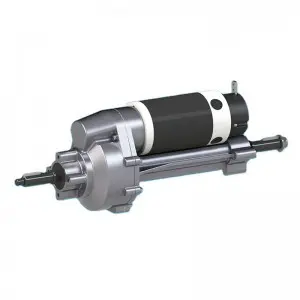If you’re a car enthusiast and enjoy fiddling with them, you’ve probably come across the term “transaxle.” An essential component of many vehicles, the transaxle combines the functions of the transmission and differential into a single unit. The K46 hydrostatic transaxle is a special type that is popular for its use in a variety of lawn mowers and small tractors. However, the question arises: Can the K46 hydrostatic transaxle be replaced with a differential? In this blog, we’ll explore this topic and delve into the intricacies of these components.
Learn about the K46 Hydrostatic Transaxle:
The K46 hydrostatic transaxle is typically found on entry-level riding lawn mowers and compact tractors. It offers seamless control of speed and direction thanks to its hydrostatic transmission, which uses fluid to transfer power from the engine to the wheels. While the K46 is known for its reliability and performance in light-duty applications, it may not be suitable for heavier tasks or demanding terrain.
To replace a K46 hydrostatic transaxle:
Given the limited capabilities of the K46 hydrostatic transaxle, some enthusiasts wondered if a differential could be used instead. Although the two components have different functions, it is possible in some cases to replace the transaxle with a differential.
Compatibility issues:
Before replacing a K46 hydrostatic transaxle with a differential, compatibility must be thoroughly evaluated. The mounting points, gear ratios and torque capacity of the transaxle need to be matched to the differential to ensure proper fit and performance. Additionally, the size and weight of the differential must be considered to avoid adversely affecting the balance and handling of the vehicle.
Performance considerations:
It is important to understand that the K46 hydrostatic transaxle and differential have different characteristics. While the differential provides equal torque to both wheels, the hydrostatic transaxle provides continuous speed control without the need to change gears. Therefore, replacing the transaxle with a differential may affect the vehicle’s handling and control. Therefore, modifications to the drivetrain, suspension, and steering system may be required to accommodate the function of the differential.
Cost-benefit analysis:
Replacing a K46 hydrostatic transaxle with a differential can be a costly affair. There may be additional costs involved in retrofitting vehicle systems beyond the cost of purchasing a suitable differential. It is important to assess whether the benefits gained from such modifications outweigh the costs involved.
Consult a Professional:
Due to the technical complexity involved in such modifications, it is strongly recommended that a professional mechanic or engineer be consulted before attempting to replace a K46 hydrostatic transaxle with a differential. These experts can provide valuable insight and guidance to ensure the transition is safe and efficient.
While it is possible to replace the K46 hydrostatic transaxle with a differential, it is a carefully considered decision. Factors such as compatibility, performance considerations, and cost-benefit analysis must be thoroughly evaluated before any action is taken. Ultimately, seeking advice from a professional in the field will help you make an informed decision that meets your vehicle requirements and overall goals.
Post time: Sep-04-2023


